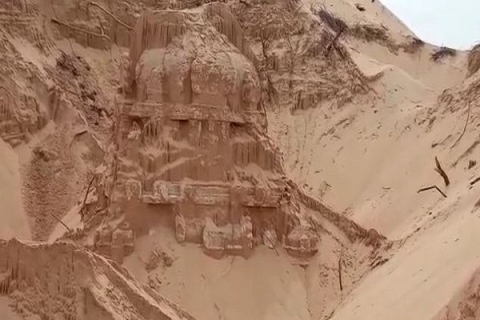200-year-old temple buried in the sand, excavated in Southeastern India
The Hindu reports that a brick temple was revealed during sand mining in southeastern India’s Penna River. Estimated to be about 200 years old, the temple may have been submerged and buried as the river changed its course after flooding in 1850, according to Rama Subba Reddy of the Archaeological Survey of India.
The ancient temple of Nageswara Swamy, which was believed to have been buried in the sand for eight decades, was located on the banks of the Penna River in the Indian Nellore district of Andhra Pradesh. Some local youth from the village of Perumallapadu under Chejerla Mandal (block) excavated the sand and discovered the temple of Siva, which it was said was consecrated by Lord Parasurama.
Archeology officials say that after 1850 floods in the Penna River the temple may have begun to bury by the sand. The floods had submerged the village and the people relocated away from the river banks.

Locals say their elders told them that sand dunes covered the entire structure about 80 years ago. They wanted to continue the sand excavation, the authorities stopped them saying this could damage the structure.
Archaeology Assistant Director Ramasubba Reddy said the higher officials would inspect the site soon and decide on the excavation and preservation works.
People from Perumallapadu and surrounding villages are thronging the place to see the temple and worship. A few policemen were deployed to guard the site.
The officials of the Archaeology and Endowments departments said they would work out a plan to restore the temple respecting the sentiments of the villagers.
It is believed that Sri Nageswara Swamy temple along with Kotiteertham temple and Sangam Sivalayam in the district were built 300 years ago. Some youth, who had returned home from various places due to the lockdown, took up sand excavation to unearth the temple.
“This has been the dream of the villagers. We had heard about the ancient temple from our elders and since we were sitting idle home, we decided to start digging work to find it. Our dream has come true,” said one of the youth.
The group of about 35 villagers said they had taken permission from the local officials before taking up the work. The villagers claimed that the temple had 110 acres of land in various villages under the Mandal.
Since the temple was buried in the sand, the revenue from the lands was being deposited in the Endowments department.
Stating that there are no accounts of the revenue earned from these lands, they demanded the authorities come out with all details and take up restoration of the temple.
A local official of Endowments department said Rs four lakh earned as rentals from the 68 acres of land was deposited in the bank. The Archaeology Department plans to hold talks with public representatives on the restoration of the temple.
Hindu religious leader Swamy Kamalananda Bharati also visited the temple on Wednesday.
Swamy, who heads the Hindu Temples Protection Committee, demanded that the authorities immediately take up works to restore the temple.
